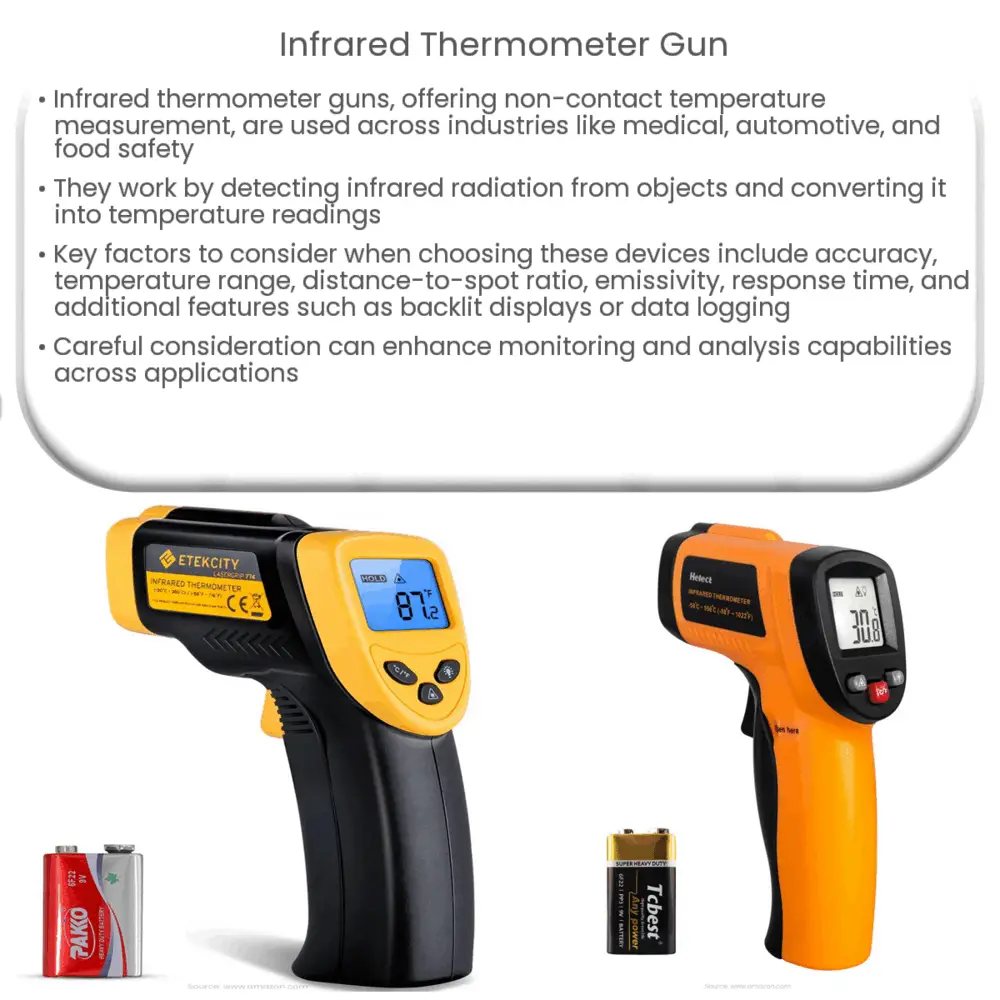Infrared thermometer guns offer non-contact, fast, and accurate temperature measurement across various industries, from medical to automotive.

Infrared Thermometer Gun: The Non-Contact Temperature Measurement Solution
Introduction
Infrared thermometer guns have revolutionized the way we measure temperature, offering a non-contact, efficient, and accurate solution. They are widely used across various industries, from automotive to medical, and have become an indispensable tool for professionals and enthusiasts alike. In this article, we will discuss the fundamentals of infrared thermometer guns, their applications, and the factors to consider when choosing one for your needs.
How Infrared Thermometer Guns Work
Infrared thermometer guns, also known as IR thermometers or laser thermometers, operate on the principle of detecting infrared radiation emitted by an object. All objects with a temperature above absolute zero emit infrared radiation, which is invisible to the human eye. Infrared thermometer guns consist of an infrared sensor, a laser, and a display unit. The infrared sensor detects the emitted radiation and converts it into an electrical signal, which is then processed by the device’s internal circuitry to provide a temperature reading.
When you aim an infrared thermometer gun at an object and pull the trigger, the laser helps you accurately target the area you want to measure. The thermometer then measures the infrared radiation from the target area and provides a temperature reading on the display. This non-contact method of measuring temperature is fast, accurate, and hygienic, making it an ideal choice for various applications.
Applications of Infrared Thermometer Guns
Infrared thermometer guns have a wide range of applications across different industries. Some of the most common uses include:
- Medical: Infrared thermometer guns are extensively used for fever screening and temperature monitoring of patients without direct contact, reducing the risk of infection.
- Automotive: Mechanics and automotive enthusiasts use IR thermometers to diagnose and troubleshoot issues related to engine temperature, cooling systems, and brakes.
- Industrial: Infrared thermometers are used for monitoring and maintaining machinery, detecting hot spots in electrical systems, and ensuring safe operating temperatures in various industrial processes.
- Food Safety: Restaurants, catering services, and food manufacturers utilize infrared thermometer guns to verify cooking temperatures, ensuring food is safe for consumption.
- Home Use: Homeowners can use infrared thermometers to check for drafts, insulation issues, and temperature variations in HVAC systems or appliances.
Factors to Consider When Choosing an Infrared Thermometer Gun
With numerous infrared thermometer guns available in the market, it’s essential to consider the following factors when selecting the right one for your needs:
- Accuracy: The accuracy of an infrared thermometer is critical, as it directly impacts the reliability of the temperature readings. Look for models with an accuracy of ±1°C (±2°F) or better.
- Temperature Range: Choose a thermometer gun with a suitable temperature range for your intended application. Some models can measure temperatures as low as -50°C (-58°F) and as high as 1000°C (1832°F).
- Distance-to-Spot Ratio: The distance-to-spot ratio (D:S) determines the size of the area you can measure from a specific distance. A higher D:S ratio allows for more precise measurements from greater distances.
Emissivity:
Emissivity is a measure of how effectively an object emits infrared radiation. Different materials have different emissivity values, which can affect the accuracy of an infrared thermometer gun. Some models offer adjustable emissivity settings to ensure accurate readings for various surfaces. If you plan to measure temperatures on a variety of materials, consider a thermometer with adjustable emissivity.
Response Time:
Response time is the duration it takes for an infrared thermometer gun to provide a temperature reading. A shorter response time allows for quicker measurements, which can be beneficial in situations where rapid temperature monitoring is necessary. Most infrared thermometers have a response time between 500 milliseconds and 1 second.
Additional Features:
Some infrared thermometer guns come with extra features that can improve usability and functionality. Examples of these features include:
- Backlit Display: A backlit display makes it easier to read temperature readings in low-light conditions.
- Data Logging: Infrared thermometers with data logging capabilities can store multiple temperature readings, allowing for easy tracking and analysis of temperature trends over time.
- Audible Alarms: Some models offer audible alarms that alert the user when a specific temperature threshold is reached, which can be useful for safety and quality control purposes.
- Connectivity: Advanced infrared thermometer guns may have Bluetooth or Wi-Fi connectivity, enabling remote temperature monitoring and integration with other devices or software.
Conclusion
Infrared thermometer guns have become an essential tool in various industries due to their non-contact, fast, and accurate temperature measurement capabilities. When choosing an infrared thermometer gun, consider factors such as accuracy, temperature range, distance-to-spot ratio, emissivity, response time, and additional features to ensure you select the right device for your specific needs. By carefully evaluating these factors, you can find the ideal infrared thermometer gun to enhance your temperature monitoring and analysis capabilities across a wide range of applications.

